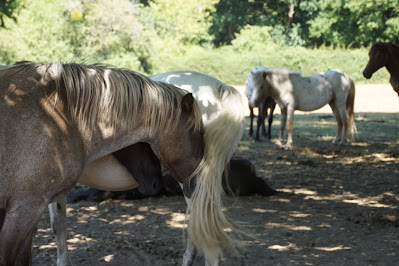The easy answer to the question "Why does my horse...." has always been, "Because he can." Yesterday I accompanied Jacqui to see her friend's horse, Maverick, a four year old bright chestnut German Warmblood. For a while now, and particularly after Maverick had some serious surgery on his hock, Jo has been seeking a new path with her horse, wanting to make sure that he has the best life possible. Rather than spoil him though, she was seeking my guidance as to which behaviours that he expresses are acceptable and unacceptable, and how to address the latter. All of his behaviours are of course normal for a horse of his age and situation, it's just that some are more inconvenient than others.
I should say that he has met with a Recommended Trainer of Intelligent Horsemanship previously and a lot of her work was evident in the way that he behaved and how well he led and could be manouvred around. Some of it just needed tightening up or revising in a small way.
Since his operation, Maverick has had six weeks of box rest with only fifteen minutes or so out in the school, and by necessity, at the end of a lunge line. It's hoped that he will be able to go out loose for a couple of hours each day by the end of this week. Considering his situation and pent up energy and emotions, he was an angel but sometimes an angel with an edge!
First of all, he has a long term - pre-house arrest - habit of pulling ghastly faces with his ears right back over the stable door. Fortunately these don't escalate to anything more and don't really seem to represent the way that he is feeling or what he is after but the face is intimidating. His mother, just a stable along to keep him company, does the same thing. I was insistent that he should smile - ears either forward or neutral - before I would give him my attention and a lovely rub. He seemed to work this out to some extent and it will need to be practiced consistently for the penny to completely drop.
Similarly, in the stable, he is fne about being approached but pulls a horrible face as you go to touch him. Some of this may relate to when vets were giving him painful injections but it is something he's always had a tendency to do. Once again, I waited until he was more relaxed and then gave him the lovely rubs that he really likes. Over time, he began to put his ears into neutral much more quickly, and Jo, Jacqui and I took it in turns to walk up to him, wait for the right ears and then give him some lovely attention. This slight pause also addresses any ambivalence he might be feeling about who is approaching him and why. It made a big difference and the nice thing about this lovely young horse is that he can be touched anywhere and he doesn't mind. There's no defensiveness around his back end at all.

I was astonished when he allowed Jo to put his headcollar on slowly and carefully with the door wide open. Considering his energy is effectively 'on charge' whenever he is confined, his age and his breeding, he was a star.
In the little sand school, Jo anticipated that he would explode at some stage and this usually followed a good roll. Having rolled, he stayed calm but as she led him around the school with the open field in his rear-view mirror, he did take off and kick out, but was polite enough to make sure he was well away from Jo. This occurred a few times and it always seem to be triggered by having his back to the open field next door. At least there was one element of predictability. On each occasion he took himself out of kicking distance from Jo. Even though her adrenaline went up, she was clearly not frightened of him.

After this we did some nice in-hand ground work, asking him to go forwards and backwards and tidied up a few aspects such as the position of Jo's hand, left and right turns, and how to ask him not to overtake. Much as we don't want a horse to dictate everything that happens, I do think that it is unfair to ask a big athletic horse, or indeed any horse, to entirely match the owner's walking pace - it is fun to see what they will do if you slow down and then to a funereal pace, but the rest of the time you do need to walk smartly so that they are set up for success and don't automatically overtake you. Of course, Maverick has long lanky legs and Jo not so much!
This pair are already so well-connected that there was not much to do and once he is settled in the field, we may work on his understandable fear of needles. Meantime, Jo can trust herself to do the right thing by her horse.
On the way home we popped in to see Chancer and then to check my own horses. When I got home I was absolutely exhausted.



















